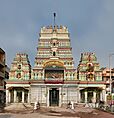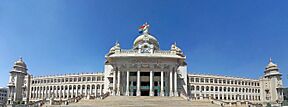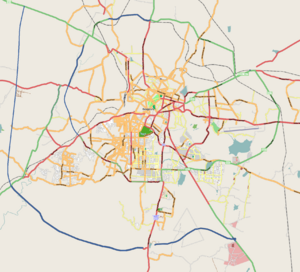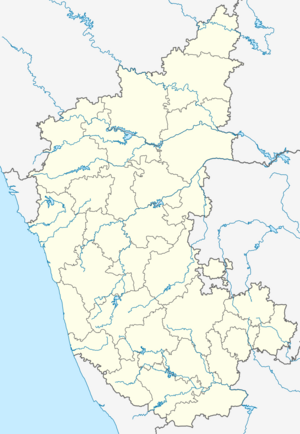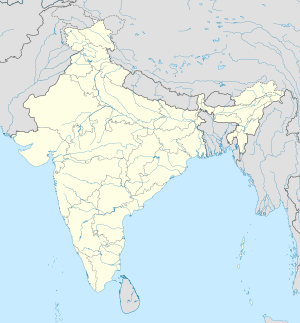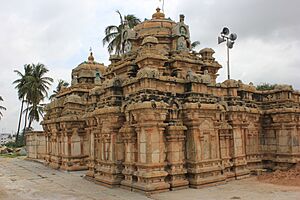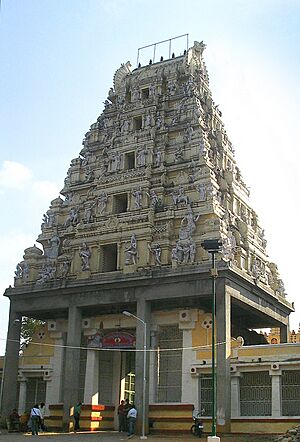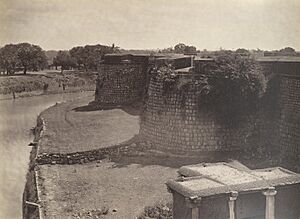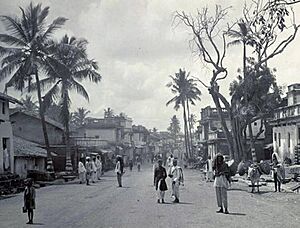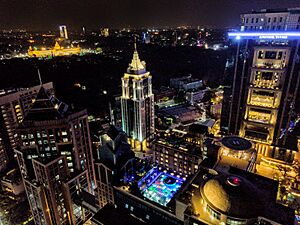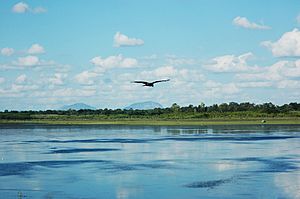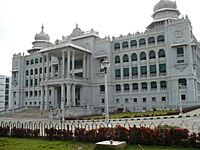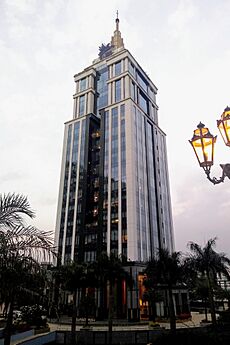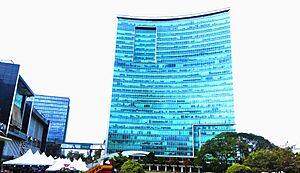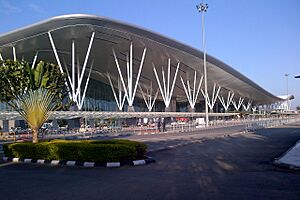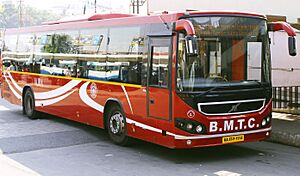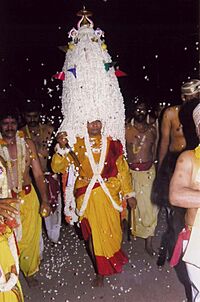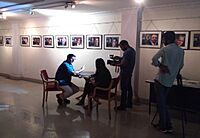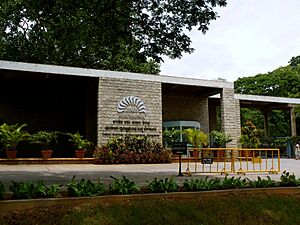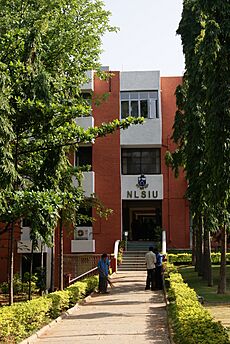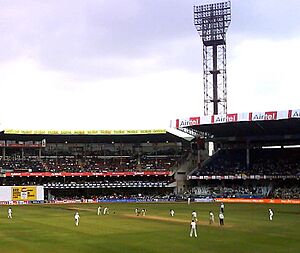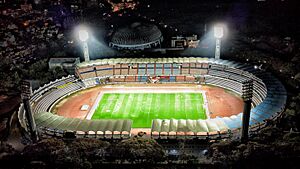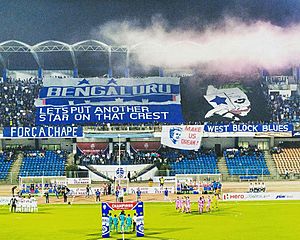Bangalore facts for kids
Quick facts for kids
Bangalore
|
|
|---|---|
| Bengaluru | |
|
Skyline of Central Business District
Dharmaraya Swamy Temple
Bangalore Palace
Halasuru Someshwara Temple
Bagmane Tech Park
Infosys pyramid
Vidhana Soudha
|
|
| Nicknames: | |
| Country | |
| State | |
| Region | Bayaluseemé |
| Districts | Bangalore Urban |
| Established | 1537 |
| Founded by | Kempe Gowda I |
| Government | |
| • Type | Municipal Corporation
|
| Area | |
| • Metropolis | 741 km2 (286 sq mi) |
| • Metro | 8,005 km2 (3,091 sq mi) |
| Elevation | 920 m (3,020 ft) |
| Population
(2011)
|
|
| • Metropolis | 8,443,675 |
| • Rank | 3rd |
| • Density | 11,395/km2 (29,513/sq mi) |
| • Urban | 10,456,000 |
| • Rank | 5th |
| Demonym(s) | Bangalorean, Bengalurinavaru, Bengalurean, Bengaluriga, Bangalori |
| Time zone | UTC+05:30 (IST) |
| Pincode(s) |
560 xxx
|
| Area code(s) | +91-(0)80 |
| Vehicle registration | KA:01-05, 41, 50-53, 57-61 |
| GDP (PPP) | $359.9 billion |
| Official language | Kannada |
Bangalore, officially known as Bengaluru, is the capital and largest city of the southern Indian state of Karnataka. It is a huge city with over 8 million people. Its larger metropolitan area has about 15 million residents. This makes it India's third most populated city.
Bangalore is located on the Deccan Plateau, high above sea level. This gives it a pleasant climate all year round. The city is famous for its many parks and green spaces. This is why it's often called India's "Garden City". It's also known as the "Silicon Valley of India" because it's a major hub for technology and software.
The city's history goes back to around 890 CE. A ruler named Kempe Gowda I built a mud fort here in 1537. This fort is seen as the beginning of modern Bangalore. Over the centuries, different empires ruled Bangalore, including the Vijayanagara Empire, the Mughals, and the Kingdom of Mysore.
In 1799, the British East India Company took control of Bangalore. Later, they moved their military base, called a cantonment, to Bangalore in 1809. This led to two parts of the city growing side-by-side: the old town and the new cantonment. After India became independent in 1947, Bangalore became the capital of Mysore State. This state was later renamed Karnataka.
Today, Bangalore is one of the fastest-growing big cities in the world. It's a major center for high-tech industries. Many large international technology companies have their main offices here. It's also home to many top engineering and research schools.
Contents
What's in a Name?
The name Bangalore comes from the city's Kannada name, Bengalūru. This name was used by Kempe Gowda I when he founded the city in 1537. The oldest mention of "Bengalūru" is from a stone carving in 890 CE.
There's a fun story about how the city got its name. A king named Veera Ballala II got lost while hunting. He was hungry and tired. An old woman gave him some boiled beans. The king was so thankful that he named the place "Benda-Kaal-uru," meaning "town of boiled beans." Over time, this name supposedly changed to "Bengalūru."
In 2006, the local government decided to officially change the city's name back to Bengalūru. This change became official on November 1, 2014.
A Look at Bangalore's Past
Evidence shows people lived in the Bangalore area as far back as 4000 BCE. Ancient Roman coins found here suggest that the region traded with the Romans around 27 BCE.
Various kingdoms ruled this area over many centuries. The Western Ganga dynasty controlled it from the 4th to the 10th centuries. Later, the Cholas took over around 1004 CE. Many temples in Bangalore, like the Chokkanathaswamy temple, were built during the Chola period.
In 1117, the Hoysala king Vishnuvardhana defeated the Cholas. Then, the powerful Vijayanagara Empire ruled the region. During this time, a dam was built across the Arkavati river. This dam helped supply water to the city.
How Modern Bangalore Began
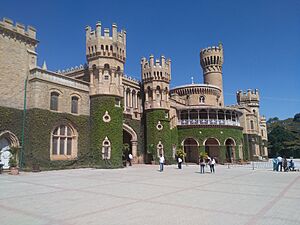
Modern Bangalore started in 1537. A local leader named Kempe Gowda I built a mud fort here. He called his new town "Land of Heroes." The town was divided into smaller areas called pētēs. The main streets, Chikkapētē and Doddapētē, met at Doddapētē Square, which was the heart of the city.
After the Vijayanagara Empire fell, Kempe Gowda I declared independence. Later, in 1638, the city came under the rule of Shahaji Bhonsle. In 1687, the Mughals captured Bangalore and sold it to the Maharaja of the Kingdom of Mysore.
When Hyder Ali took control of the kingdom, Bangalore became an important military and trade center. He and his son, Tipu Sultan, built the beautiful Lal Bagh Botanical Gardens in 1760.
British Influence and Growth
In 1791, British forces captured the Bangalore fort. After Tipu Sultan's death in 1799, the British gave control of the city back to the Maharaja of Mysore. The old city continued to grow under the Maharaja's rule.
In 1809, the British moved their military base (cantonment) to Bangalore. A new town grew around this base. This new area had its own government. In 1853, telegraph lines connected Bangalore to other major Indian cities. A railway line to Chennai was built in 1864. These connections helped the city grow quickly.
Bangalore in Recent Times
By the 19th century, Bangalore became like a "twin city." There was the old "pētē" area, mostly with local people, and the British-controlled cantonment. The cantonment grew and became a diverse place with British and Anglo-Indian army officers.
In 1898, a serious plague hit Bangalore. This led to improvements in the city's sanitation. Telephone lines were installed to help fight the plague. In 1906, Bangalore was one of the first Indian cities to get electricity from hydro power. The Indian Institute of Science was founded in 1909. This helped Bangalore become a center for science research. In 1912, the Bangalore torpedo, an explosive weapon used in World War I and II, was invented here.
Bangalore became known as the "Garden City of India" in 1927. This was during celebrations for King Krishnaraja Wodeyar IV. Many parks and public buildings were built. Mahatma Gandhi visited the city in 1927 and 1934.
After India gained independence in 1947, Bangalore became the capital of Mysore State. In 1949, the old city and the cantonment merged to form the Bangalore City Corporation. Bangalore grew rapidly as many people moved here for jobs and education.
In the 1980s, Texas Instruments became the first international company to set up in Bangalore. Many other technology companies followed. By the end of the 20th century, Bangalore was known as the "Silicon Valley of India." Today, it's India's third most populated city.
Bangalore's Location and Environment
Bangalore is in the southeast of Karnataka, in southern India. It sits on the Mysore Plateau, which is part of the larger Deccan Plateau. The city is about 900 meters (3,000 feet) above sea level. This high elevation helps keep the climate mild.
The city's landscape is mostly flat. There are no major rivers flowing through Bangalore itself. However, the Arkavathi and South Pennar rivers are nearby. The Vrishabhavathi River, a smaller river, starts in the city and carries much of Bangalore's sewage.
In the 16th century, Kempe Gowda I built many lakes to supply water to the town. Today, Bangalore gets most of its water from the Kaveri River. Even though it receives a lot of water, the city sometimes faces water shortages, especially in summer.
Bangalore has several freshwater lakes and water tanks. Some of the largest are Madivala tank, Hebbal Lake, and Ulsoor Lake. Sadly, about 90% of Bangalore's lakes are polluted. The city government is working to clean them up.
The city's plant life mainly consists of large deciduous trees and some coconut trees. Bangalore is in a stable seismic zone, but it has experienced small earthquakes.
Bangalore's Climate
Bangalore has a tropical climate with clear wet and dry seasons. Because it's high up, the weather is usually mild all year. January is the coolest month, and April is the hottest. The highest temperature ever recorded was 39.2°C (102.6°F) in April 2016. The lowest was 7.8°C (46.0°F) in January 1884.
Bangalore gets rain from both the northeast and southwest monsoons. September, October, and August are the wettest months. Summer heat is often cooled by thunderstorms. Most rain falls in the late afternoon or evening. In November 2015, heavy rains caused severe flooding in some areas. In 2022, Bangalore had much more rain than usual, leading to floods and power cuts.
People of Bangalore
| Population growth | ||
|---|---|---|
| Year | Pop. | ±% |
| 1941 | 406,760 | — |
| 1951 | 778,977 | +91.5% |
| 1961 | 1,207,000 | +54.9% |
| 1971 | 1,654,000 | +37.0% |
| 1981 | 2,922,000 | +76.7% |
| 1991 | 4,130,000 | +41.3% |
| 2001 | 5,101,000 | +23.5% |
| 2011 | 8,425,970 | +65.2% |
| Source: Census of India | ||

Bangalore is a huge city with a population of over 8.4 million people. It's the third most populated city in India. Between 1991 and 2001, Bangalore was the fastest-growing Indian city after New Delhi. People who live in Bangalore are called "Bangaloreans." Many people from other parts of India move to Bangalore for school or work.
| Religion in Bangalore City (2011) | ||||
|---|---|---|---|---|
| Religion | Percent | |||
| Hinduism | 78.87% | |||
| Islam | 13.90% | |||
| Christianity | 5.61% | |||
| Jainism | 0.97% | |||
| Sikhism | 0.15% | |||
| Buddhism | 0.06% | |||
| Others | 0.44% | |||
In 2020, Bangalore was ranked the most livable Indian city for populations over a million. However, like many fast-growing cities, Bangalore faces challenges. These include increasing social inequality and problems with water supply and sewage in poorer areas.
Languages Spoken in Bangalore
The official language of Bangalore is Kannada. About 42% of the people speak Kannada. Other widely spoken languages include Tamil, Telugu, Urdu, and Hindi.
A local version of Kannada, called 'Bangalore Kannada', is spoken here. English is also widely used, especially by professionals and in business. Many people from other states have moved to Bangalore. This makes the city very diverse in terms of languages and cultures.
How Bangalore is Governed
The city's daily management is handled by the Bruhat Bengaluru Mahanagara Palike (BBMP). This is the Greater Bangalore Municipal Corporation. It was formed in 2007 by combining smaller councils and villages. The BBMP has 243 wards, and a city council with 250 members. These members include elected representatives from each ward and members of Parliament.
Elections for the council happen every five years. A mayor and deputy mayor are chosen from the elected members. The BBMP works with other groups like the Bangalore Development Authority (BDA). They plan and carry out projects to improve the city.
Bangalore's fast growth has led to some challenges. These include traffic jams and issues with city services. The city has tried different traffic systems to help.
The Bangalore City Police (BCP) keeps the city safe. It has different units like the Traffic Police and the Central Crime Branch. As the capital of Karnataka, Bangalore also has important state government buildings. These include the Karnataka High Court and the Vidhana Soudha, where the state legislature meets.
Electricity in Bangalore is managed by BESCOM. Water supply and sanitation are handled by BWSSB.
Waste Management and Pollution
As of 2022, Bangalore produces about 6,000 metric tonnes of solid waste every day. This waste is taken to dumping sites. The city also faces problems with dust pollution and hazardous waste. The Whitefield area, a big IT hub, is one of the most polluted parts of Bangalore.
The city government is working to improve air quality. They are also trying to manage waste better.
Bangalore's Economy
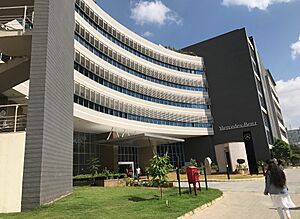
Bangalore is one of India's fastest-growing cities. It contributes 38% of India's total IT exports. The city's economy mainly focuses on services and industry. This includes information technology, telecommunications, and biotechnology. It also has manufacturing for electronics, machinery, and cars.
Bangalore is known as the "Silicon Valley of India." It's the country's biggest IT hub. Companies like Infosys, Wipro, and Flipkart have their main offices here. The IT industry in Bangalore is divided into major areas like Software Technology Parks of India (STPI) and Electronic City.
The city is also a major center for biotechnology. In 2005, nearly half of India's biotechnology companies were in Bangalore. This has earned it the nickname "Biotech Capital of India." Bangalore is also a big market for everyday consumer goods. Forbes magazine has called Bangalore one of "The Next Decade's Fastest-Growing Cities."
Getting Around Bangalore
By Air
Bangalore is served by Kempegowda International Airport. It's about 40 kilometers (25 miles) from the city center. This airport started operating in 2008. It is the third-busiest airport in India. You can get to the airport by taxi or special air-conditioned buses.
By Train and Metro
Bangalore has a rapid transit system called the Namma Metro. It opened in 2011. Metro lines now cover 42.30 kilometers (26.28 miles). More lines are being built, including an extension to the airport.
Bangalore is an important railway hub. There are four main railway stations in the city. These stations connect Bangalore to other parts of Karnataka and neighboring states. There are also plans for a suburban rail service. This would help people who work in the IT areas like Whitefield.
By Bus and Auto
Buses are a very common way to get around Bangalore. The Bangalore Metropolitan Transport Corporation (BMTC) runs these buses. You can buy tickets on the bus or get a bus pass. BMTC also has luxury air-conditioned buses and shuttle services to the airport.
The Karnataka State Road Transport Corporation (KSRTC) runs buses that connect Bangalore to other parts of Karnataka and nearby states. Bangalore was one of the first cities in India to use Volvo city buses.
Three-wheeled auto-rickshaws, called autos, are also popular for transport. They use meters and can carry up to three passengers. Taxis are also available, usually by phone or online. They are more expensive than autos.
By Road

Bangalore is well-connected by national highways. These highways link the city to the rest of the country. About 1,750 new vehicles are registered in Bangalore every day. The city's roads cover about 11,000 kilometers (6,800 miles).
Bangalore has one expressway, the Bangalore–Mysore Expressway. More expressways are planned for the future. These will make travel to and from the city even easier.
Bangalore's Culture
Bangalore is known as the "Garden City of India." This is because of its many trees, wide streets, and public parks like Lal Bagh and Cubbon Park. In 2012, Lonely Planet ranked Bangalore among the top ten cities to visit worldwide.
Flower shows are held twice a year at the Lal Bagh Botanical Gardens. These happen around India's Republic Day and Independence Day. The Bangalore Karaga is one of the city's oldest festivals. It is dedicated to the goddess Draupadi and is celebrated for nine days in March or April.
Karnataka Rajyotsava is celebrated on November 1st. This day marks the formation of the state of Karnataka. Other popular festivals include Ugadi, Ram Navami, Eid ul-Fitr, Ganesh Chaturthi, Dasara, Deepawali, and Christmas.
Bangalore's food scene is very diverse. You can find street food, tea stalls, and restaurants serving South Indian, North Indian, Chinese, and Western fast food. Udupi restaurants are popular for their vegetarian food. Bangalore is also known as India's most vegan-friendly city.
Art, Literature, and Entertainment
Bangalore has a growing art scene. Several art galleries have opened since the 1990s. The city also hosts an international art festival called Art Bangalore.
Kannada literature has a long history in Bangalore. The city is home to the Kannada Sahitya Parishat, an organization that promotes the Kannada language. Bangalore also has its own literary festival.
The Karnataka Chitrakala Parishath is an art gallery with paintings and sculptures. The Indian Cartoon Gallery is the first of its kind in India. It showcases cartoon exhibitions every month.
Bangalore is home to the Kannada film industry, which makes about 200 films each year. The city also has a lively theater scene. Popular theaters include Ravindra Kalakshetra and Ranga Shankara.
Bangalore is a major center for Indian classical music and dance. You can find performances of Carnatic and Hindustani classical music. Dance forms like Bharat Natyam and Kathak are also very popular. Yakshagana, a traditional theater art from coastal Karnataka, is often performed.
While classical music is popular, rock music is very big in urban Bangalore. The city even has its own style of rock called "Bangalore Rock." Bangalore is sometimes called the "Pub Capital of India" and the "Rock/Metal Capital of India" because of its music scene.
Learning in Bangalore
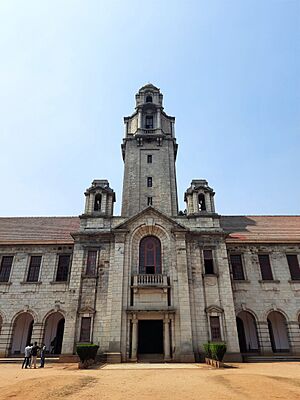
Bangalore has a high literacy rate of about 88%. Until the early 19th century, education was mainly run by religious leaders. The British introduced the Western system of education. The first English school, the Wesleyan Canarese School, was established in 1832.
Schools in Bangalore follow different education boards. These include the Central Board of Secondary Education (CBSE) and the International Baccalaureate (IB). Many international schools are also available due to the large number of foreign residents and IT workers.
After secondary school, students can go to a pre-university course or a high school course in arts, commerce, or science. They can also enroll in diploma courses. After that, students can pursue degrees at universities.
Universities and Research
The Central College of Bangalore, founded in 1858, is the city's oldest college. Bangalore University was established in 1886. It is connected to over 500 colleges and has more than 300,000 students.
Some of the most important research institutes in Bangalore include the Indian Institute of Science and the National Centre for Biological Sciences. There are also many private universities and medical colleges in the city.
Media and Communication
The first printing press in Bangalore was set up in 1840. The first English newspaper, Bangalore Herald, was published in 1859. The Mysore Vrittanta Bodhini was the first Kannada newspaper in 1860.
Today, Vijaya Karnataka and The Times of India are the most popular newspapers in Kannada and English. All India Radio started broadcasting from Bangalore in 1955. In 2001, Radio City became the first private FM radio channel in India to broadcast from Bangalore.
Bangalore got its first television network in 1981. Doordarshan started a news program in Kannada in 1983. Star TV was the first private satellite channel in Bangalore in 1991.
The first Internet service provider in Bangalore started in the early 1990s. Bangalore has the most broadband internet connections in India. Namma Wifi is a free public wireless network in Bangalore. It started in 2014 and was the first free WiFi in India. Bangalore was also the first city in India to get 4G mobile internet services.
Sports in Bangalore
Cricket is the most popular sport in Bangalore. Many famous national cricketers, like Rahul Dravid and Anil Kumble, are from Bangalore. The city's international cricket stadium is the M. Chinnaswamy Stadium. It can hold 40,000 people. It has hosted many important matches, including World Cup games. It is also home to the Indian Premier League (IPL) team, Royal Challengers Bangalore.
Association football (soccer) is also popular. Bangalore is home to Indian Super League (ISL) team Bengaluru FC. The city also hosts tennis tournaments.
Bangalore has many sports clubs. Famous tennis players like Mahesh Bhupathi and Rohan Bopanna live here. Other sports stars from Bangalore include swimmer Nisha Millet and snooker champion Pankaj Advani.
The Kanteerava Indoor Stadium has hosted basketball and kabaddi matches. The Bengaluru Bulls is a team in the Pro Kabaddi League.
| Club | Sport | League | Stadium | Span |
|---|---|---|---|---|
| Bangalore Warhawks | American football | EFLI | HAL Sports Complex | 2012– |
| Bengaluru Beast | Basketball | UBA | 2015– | |
| Bengaluru Raptors | Badminton | PBL | Koramangala Indoor Stadium | 2013– |
| Bangalore Raptors | Tennis | Champions Tennis League | KSLTA Tennis Stadium | 2014–2014 |
| Bengaluru Bulls | Kabaddi | PKL | Kanteerava Indoor Stadium | 2014– |
| Bengaluru FC | Football | Indian Super League | Sree Kanteerava Stadium | 2013– |
| FC Bengaluru United | Football | I-League 2nd Division | Bangalore Football Stadium | 2018– |
| SC Bengaluru | Football | I-League 2nd Division | Bangalore Football Stadium | 2022– |
| HAL Bangalore | Football | I-League | Bangalore Football Stadium | N/A |
| Ozone FC | Football | I-League 2nd Division | Bangalore Football Stadium | 2015– |
| South United FC | Football | I-League 2nd Division | Bangalore Football Stadium | 2013– |
| Bangalore Hi-Fliers | Field hockey | PHL | Bangalore Hockey Stadium | 2005–2008 |
| Karnataka Lions | Field hockey | WSH | Bangalore Hockey Stadium | 2011–2012 |
| Royal Challengers Bangalore | Cricket | IPL | M. Chinnaswamy Stadium | 2008– |
| Bengaluru Torpedoes | Volleyball | Prime Volleyball League | Koramangala Indoor Stadium | 2021– |
Sister Cities
Bangalore has special connections with other cities around the world. These are called "sister cities."
 Minsk, Belarus (1973)
Minsk, Belarus (1973) Cleveland, United States (1992)
Cleveland, United States (1992) San Francisco, United States (2008)
San Francisco, United States (2008) Chengdu, China (2013)
Chengdu, China (2013)
See also
 In Spanish: Bangalore para niños
In Spanish: Bangalore para niños



